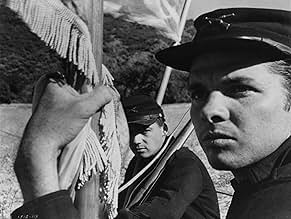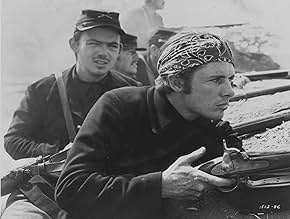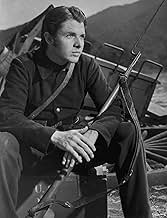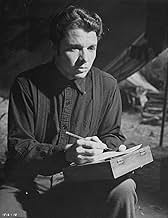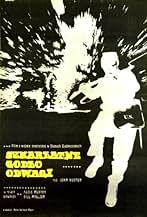VALUTAZIONE IMDb
7,1/10
5158
LA TUA VALUTAZIONE
Un adattamento troncato dell'omonimo romanzo di Stephen Crave su un soldato dell'Unione durante la Guerra Civile che fatica a trovare il coraggio per combattere nel cuore della battaglia.Un adattamento troncato dell'omonimo romanzo di Stephen Crave su un soldato dell'Unione durante la Guerra Civile che fatica a trovare il coraggio per combattere nel cuore della battaglia.Un adattamento troncato dell'omonimo romanzo di Stephen Crave su un soldato dell'Unione durante la Guerra Civile che fatica a trovare il coraggio per combattere nel cuore della battaglia.
- Regia
- Sceneggiatura
- Star
- Nominato ai 1 BAFTA Award
- 2 vittorie e 1 candidatura in totale
Robert Easton
- Thompson
- (as Robert Easton Burke)
Don Anderson
- Soldier
- (non citato nei titoli originali)
Smith Ballew
- Union Captain
- (non citato nei titoli originali)
Albert Band
- Union Soldier Fording River
- (non citato nei titoli originali)
Gregg Barton
- Soldier
- (non citato nei titoli originali)
Whit Bissell
- Wounded Officer
- (non citato nei titoli originali)
Robert Board
- Soldier
- (non citato nei titoli originali)
Chet Brandenburg
- Wounded Soldier
- (non citato nei titoli originali)
Edwin Breen
- Confederate Flag Bearer
- (non citato nei titoli originali)
Joe Brown Jr.
- Soldier
- (non citato nei titoli originali)
Recensioni in evidenza
Those who think Audie Murphy was not a very good actor haven't seen him in this film. Perhaps some of his later Western films didn't give him as much to work with, but in Red Badge of Courage he shines. Just a few of many great scenes which come to mind: early in the film when he hears that his group will finally be going into action, he writes a letter to his pa 'in case you are told that I have fallen', and you can see the remains of tears drying on his face; later on when his friend Jim dies after the first real battle, in Murphy's reaction you can see how wrenching it is for him to realize the human cost of war. Bill Mauldin, the famous cartoonist, plays the role of Murphy's closest friend in his fighting group, and does a superb job as well. Both Murphy and Mauldin seem perfectly suited to the age of their characters. While they were not originally actors by trade and had little if any acting experience, their performances in this film should shame many of today's 'actors' who draw multi million dollar paychecks and whose 'work' pales in comparison to that of Murphy and Mauldin in this film.
My only real disappointment was that due to massive editing the film is only 69 minutes long! I figured it was at the midway point when 'the end' came on the screen. Apparently this film became a sort of political football within the studio when it was made, yet I can't understand how anyone could justify cutting it down to this length. I was thoroughly enjoying this film all the way through and was nowhere near ready for it to end. Even so, even if you're not a Civil War buff, this is an excellent film with very engaging performances. It's more about the people than it is the war. Highly recommended.
My only real disappointment was that due to massive editing the film is only 69 minutes long! I figured it was at the midway point when 'the end' came on the screen. Apparently this film became a sort of political football within the studio when it was made, yet I can't understand how anyone could justify cutting it down to this length. I was thoroughly enjoying this film all the way through and was nowhere near ready for it to end. Even so, even if you're not a Civil War buff, this is an excellent film with very engaging performances. It's more about the people than it is the war. Highly recommended.
Such a darn shame so much of the film was lost during a power struggle at MGM. What remains is a strong drama adapted from the Crane novel. Some call it an anti-war film, but that's a stretch since Audie Murphy's youthful soldier proves himself in battle after a cowardly initiation, and receives the admiration of his buddies. The sequence is more like a rite of passage than a denunciation.
The somewhat amateur cast is outstanding. I expect the untrained Murphy felt a personal commitment to his role and comes through just as professionally as he did in real life. Untrained cartoonist Bill Mauldin also looks and acts the part of callow youth maturing under pressures of life or death situations. His big ears are especially persuasive for a Hollywood setting.
And what burst of inspiration led the normally glamor-obsessed Tiffany of Studios to cast such affecting unlovelies as John Dierkes and Royal Dano in key parts. It's Dierkes's ill-fated salt-of-the-earth soldier that injects real tragedy into the sparse dialogue. With his craggy face and towering body he's every inch the early American primitive. And, of course, there's Dano with his gaunt face, wasted body, and graveyard voice, who helps make that line of wounded soldiers (the real core of the film) an unforgettable procession. Nor should that genuine face of war, the battle-shocked soldier deliriously bellowing The Battle Hymn of the Republic as he trudges along, be overlooked. And for a little humorous relief, who can forget the general whose pep-talk to each unit sounds like a broken record with a big stomach, but whose humanity shines through anyway.
The sweeping battlefields are effective in their look and feel, even if it is the scrublands of SoCal in the distance. Note all the dust and smoke obscuring vision, along with the chaotic criss-crossing of other units going here and there, but we don't know where. The effect is that of focusing our concerns on the familiar faces rather than on who's winning or losing the battle, which, I gather, is the way most infantry experience battle. It's been called understandably "the fog of war".
I like the brief lyrical moments that remind us of a larger world outside the stage of human conflict. Actually, Murphy is quite good at portraying sensitivity, as for example when he turns away from the raucous byplay at the farm house. The quiet moments with him and Mauldin are rather touching in that they look like two average Joe's showing the personal side of war. But, as Murphy proved in both the movie and real life, you never know the depths that may be concealed under that ordinary appearance.
I believe it was critic Andrew Sarris who pointed out that John Huston's career was never the same after MGM got through editing out an hour of his version and throwing the rest away. Now we can only guess how many other affecting scenes were tossed out in the process. Obviously, the project was close to Huston's heart being an adaptation of a great American novel from its most wrenching national conflict. I don't know whether to be happy or sad that this severely truncated version was finally marketed. It's good, but then there's the promise of so much more. Too bad the production didn't migrate to a less image-conscious studio.
The somewhat amateur cast is outstanding. I expect the untrained Murphy felt a personal commitment to his role and comes through just as professionally as he did in real life. Untrained cartoonist Bill Mauldin also looks and acts the part of callow youth maturing under pressures of life or death situations. His big ears are especially persuasive for a Hollywood setting.
And what burst of inspiration led the normally glamor-obsessed Tiffany of Studios to cast such affecting unlovelies as John Dierkes and Royal Dano in key parts. It's Dierkes's ill-fated salt-of-the-earth soldier that injects real tragedy into the sparse dialogue. With his craggy face and towering body he's every inch the early American primitive. And, of course, there's Dano with his gaunt face, wasted body, and graveyard voice, who helps make that line of wounded soldiers (the real core of the film) an unforgettable procession. Nor should that genuine face of war, the battle-shocked soldier deliriously bellowing The Battle Hymn of the Republic as he trudges along, be overlooked. And for a little humorous relief, who can forget the general whose pep-talk to each unit sounds like a broken record with a big stomach, but whose humanity shines through anyway.
The sweeping battlefields are effective in their look and feel, even if it is the scrublands of SoCal in the distance. Note all the dust and smoke obscuring vision, along with the chaotic criss-crossing of other units going here and there, but we don't know where. The effect is that of focusing our concerns on the familiar faces rather than on who's winning or losing the battle, which, I gather, is the way most infantry experience battle. It's been called understandably "the fog of war".
I like the brief lyrical moments that remind us of a larger world outside the stage of human conflict. Actually, Murphy is quite good at portraying sensitivity, as for example when he turns away from the raucous byplay at the farm house. The quiet moments with him and Mauldin are rather touching in that they look like two average Joe's showing the personal side of war. But, as Murphy proved in both the movie and real life, you never know the depths that may be concealed under that ordinary appearance.
I believe it was critic Andrew Sarris who pointed out that John Huston's career was never the same after MGM got through editing out an hour of his version and throwing the rest away. Now we can only guess how many other affecting scenes were tossed out in the process. Obviously, the project was close to Huston's heart being an adaptation of a great American novel from its most wrenching national conflict. I don't know whether to be happy or sad that this severely truncated version was finally marketed. It's good, but then there's the promise of so much more. Too bad the production didn't migrate to a less image-conscious studio.
Keep in mind that many people involved with this film were WW2 vets. That's important, as I think it made a HUGE difference in how the film came out. Audie Murphy was the most decorated American soldier of WW2. Bill Mauldin wasn't a line soldier, but he'd been in the infantry before the war. He knew what the daily life of a grunt was all about. And director John Huston had directed films in WW2, standing at the front lines in Italy to do so. They all knew what war should look like. Had these people not been involved, I think this movie wouldn't have rung true as it did then and does today. Sure, the weapons, most of the uniforms and equipment are horribly wrong (this was in the days when a "trapdoor" Springfield rifle and Indian War era equipment was just fine for a Civil War film), but this film must be viewed on it's acting and photography. They got it across what it was like to be SHOT at, and how it felt to be terrified in battle, better than any film since, "All Quiet of the Western Front." Yes, it's seriously abridged and condensed (quite a feat when you consider how short the book is), but it gets the spirit across just fine. It's not perfect by any measure, but you'll never be able to get such a group together to re-make this film and have ring as trued as this classic.
This movie, directed by John Huston, is arguably the finest Civil War movie of all time. The performances by the young Audie Murphy,America's most decorated soldier and all the cast are as true to life as can be found anywhere. The narration and ultra-realism gives an almost docu-drama feel. This movie is so short,at 69 minutes, that it never had a chance at the box office, and instead was probably seen mostly by school kids and a few old movie buffs. The only other movie that is almost as short and so successfully tells a story is "The Petrified Forest". The Red Badge of Courage is on my best movies of all time list.
Deserves more credit than it currently receives. The directing alone is awesome, with the number of unique and different shots that Huston came up with really takes this Pic away from the norm.
Some of the realism in the portrayals that would be lost on some American viewers include the scene where the General talks to the troops before the battle, asking them what they are going to eat for dinner. He goes from group to group asking the same questions - why? Remember (duh), no radios, no public address system. Commanders had to spread their message by repeating it over and over - inspiring a different group each time.
A very enjoyable 69 minutes. Sad that the studio had to meddle with the original cut (what else is new?).
F
Some of the realism in the portrayals that would be lost on some American viewers include the scene where the General talks to the troops before the battle, asking them what they are going to eat for dinner. He goes from group to group asking the same questions - why? Remember (duh), no radios, no public address system. Commanders had to spread their message by repeating it over and over - inspiring a different group each time.
A very enjoyable 69 minutes. Sad that the studio had to meddle with the original cut (what else is new?).
F
Lo sapevi?
- QuizAfter seeing what MGM had done to the film, John Huston instructed his agent to include a clause in all future contracts guaranteeing that he would receive a copy of his director's cut on all of his films.
- BlooperAll the soldiers in Audie's infantry outfit have crossed rifles on their forage hats. The crossed rifle insignia was not adopted by the US army until the year 1876, before this it was a hunter's horn.
- Citazioni
The General: Howdy Jim, Corporal. How are those wounds?
Soldier: Stinging some, General, but they're a-mending.
The General: That's fine, fine. Anybody care for a chaw?
- ConnessioniEdited into Hollywood: The Dream Factory (1972)
I più visti
Accedi per valutare e creare un elenco di titoli salvati per ottenere consigli personalizzati
- How long is The Red Badge of Courage?Powered by Alexa
Dettagli
Botteghino
- Budget
- 1.640.000 USD (previsto)
- Tempo di esecuzione1 ora 9 minuti
- Colore
- Proporzioni
- 1.37 : 1
Contribuisci a questa pagina
Suggerisci una modifica o aggiungi i contenuti mancanti

Divario superiore
By what name was La prova del fuoco (1951) officially released in India in English?
Rispondi

